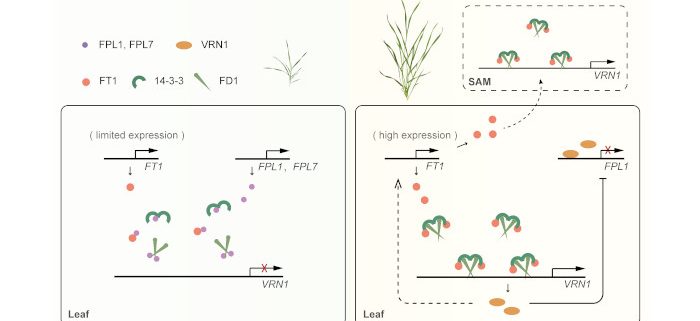A regulatory loop involving FLOWERING PROMOTING FACTOR1-like proteins, VERNALIZATION1, and FLOWERING LOCUS T1 represses flowering in Brachypodium distachyon
Liu et al. identify two proteins that repress flowering by acting on the florigen activation complex.
https://doi.org/10.1093/plcell/koad190
Background: Timely flowering is critical for plant reproductive success. FLOWERING PROMOTING FACTOR1 (FPF1), a small protein without any known domains, has been shown to promote flowering in several plants, including Arabidopsis (Arabidopsis thaliana), tobacco (Nicotiana tabacum) and rice (Oryza sativa); however, the mechanism by which FPF1 functions remains unknown.
Question: How do FPF1 and FPF1-Like (FPL) proteins regulate flowering time in the model temperate grass Brachypodium distachyon?
Findings: We characterized two B. distachyon FPF1-like proteins, FPL1 and FPL7. In contrast to FPF, which promotes flowering in several plants, FPL1 and FPL7 repress flowering under long-day conditions in B. distachyon. FPL1 and FPL7 interact with the components of the florigen activation complex and complex formation as well as its activity to restrict expression of its critical target, VERNALIZATION 1 (VRN1) expression in leaves, thereby preventing subsequent over-accumulation of FLOWERING LOCUS T 1 (FT1) at the juvenile stage to avoid premature flowering. At the late vegetative stage, VRN1 directly binds the FPL1 promoter and represses FPL1 expression as it gradually accumulates, thus allowing proper FT1 expression in leaves and ensuring sufficient florigen activation complex formation in shoot apical meristems to initiate timely flowering.
Next steps: It will be interesting to investigate additional upstream regulators and the potential transport of FPL1 and FPL7 in grasses. In addition, the function of FPL1 orthologs in other plants remains to be determined.
Shu Liu, Siyi Chen, Yang Zhou, Yuxin Shen, Zhengrui Qin, Liang Wu (2023) VERNALIZATION1 Represses FLOWERING PROMOTING FACTOR1-LIKE1 in Leaves for Timely Flowering in Brachypodium distachyon. https://doi.org/10.1093/plcell/koad190




